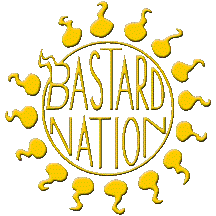Herding Cats, Part 3, "Bastard Nation, A Band Apart"

In Part 2 of Herding Cats I described the how the organizational structure of the American Adoption Congress determined its primary focus and limited its ability to lead a national campaign to reform adoption records access laws. In this section I will discuss Bastard Nation, its organizational structure and its capacity for national leadership.
The story of the creation of Bastard Nation has been repeated numerous times, and can be found on the BN website. In short, a varied group, consisting primarily of adoptees, began a discourse on the internet Usenet newsgroup alt.adoption though the use of signature files at the end of their posts identifying themselves as functionaries in a fictitious organization named Bastard Nation. The discourse was highly charged, many felt that using the name Bastard Nation and, indeed, using the term “bastard”, let alone to identify with the term, was offensive in the extreme. Many of the original Bastard Nationals, the self-named Founding Foundlings, felt the energy this discourse was generating was entertaining, stimulating, and, in the end, held power beyond the relatively small world of the internet adoption community. Among these early Bastards, Marley Greiner, Damsel Plum, Lainie Petersen and Shea Grimm decided to form an actual organization out of this informal internet network.
From the first, Shea, Damsel, Marley and the other Founding Foundlings of Bastard Nation determined that BN would be adoptee-led. These early leaders had experienced first-hand the legacy of adoption-professional advocacy strategies of the AAC, and strongly believed that the best way to shift the discourse of adoption reform was to wrest control of the movement from the professional class. Bastard Nation remains the sole adoptee-led adoption organization in the United States.
Shea Grimm has written that the transition from informal network to real-world organization came about so quickly that it surprised her, which is remarkable considering that she led the team that formed Bastard Nation. She made the decision to form Bastard Nation as a 501(c)4 non-profit, as opposed to a 501(c)3. This marked BN profoundly different from the AAC, not only in its Mission, but also in its major activities.
501(c)4’s may accept individual and corporate donations, but these gifts are not tax-deductible. 501(c)4’s may not apply for nor accept foundation grants. These strictures limit fiscal development, but as a trade-off, 501c4’s may devote their entire organizational resources to political organizing and advocacy. This placed Bastard Nation at an immediate advantage over the AAC in terms of fundraising strategies, because every dollar BN raised could be devoted to direct Open Records advocacy while the AAC could only use 20% or less of its monies directly in the same effort. This applies not only to money, but to organizational expenditures of resources; i.e. staff time and activities.
Bastard Nation’s Mission and activities are narrowly focused on the assertion of adoptee rights, specifically the right to unlimited access to original birth records. Like the AAC, BN hosted national conferences for the first five years of its existence, but the primary purpose of these conferences were to strategize and hone tactics for contemporary and planned legislative actions. Because of this narrow focus, people who were attracted to join BN did so with the expectation that they would learn to become effective activists.

Bastard Nation was modeled, consciously or not, on the model of a revolutionary cadre. At the top of the organization was the Executive Committee (ExecComm), originally consisting of Ms. Grimm, Plum, Greiner and Lainie Petersen (who resigned for personal reasons after one month. I replaced Ms. Petersen at the first BN National Conference in 1997 and resigned from leadership in 2001), who also functioned as the Board of the non-profit. Various subcommittees were formed to distribute work and responsibilities, but all committee members served at the pleasure of the ExecComm. This narrow locus of power meant BN had greater flexibility than larger, bureaucracy-bound, groups, like the AAC, which tend to be risk-averse. Almost immediately after launching the organization at their first national conference, BN demonstrated this flexibility by planning what became the Measure 58 campaign, the first adoption records access reform ballot initiative. At the same time, Bastard Nation weighed in on legislative campaigns in other states, including providing guidance and resources to the successful campaign in Alabama.
The win in Oregon proved that Bastard Nation’s strategies, including adoptee-led campaigns and the focus on civil rights, had resonance in the general public, and more importantly, could win. The success also highlighted the structural weaknesses in BN. Like the AAC, BN is completely staffed by volunteers. Hewing to the Internet zeitgeist that that allowed it to flourish, BN has had no central office, nor little of the infrastructure of traditional political organizations. Leaders donated the funds to run day-to-day operations; such as website and printing costs, and events like the national conferences became underwritten by generous individuals within the organization. BN went from being a small internet phenomenon to a national adoption political player in a year, but was limited by a lack of planning to foster fundraising and membership growth. This limitation still hobbles Bastard Nation.
Maureen Flatley, veteran political operative, gave a presentation at BN’s Third Annual National Conference in Atlantic City which outlined some of the challenges to risk-embracing, cutting-edge political organizations. She noted that the effective life-span of organizations like Queer Nation and Act Up was an average of four or five years before either organizational entropy or external political change served to strip cutting-edge groups of their power to shake things up and they either become more mainstream or more marginalized. And as Bastard Nation evolved from a band of political and cultural “outlaws” to a group with a seat at the table of the national discourse on adoption politics by virtue of the win in Oregon, it became apparent that the organization was limited by its own organizational and cultural identity to mature into this role.
Internal discussions began on these matters soon after Measure 58’s victory, with some suggesting that the very name of the organization, which had garnered it cultural power and notoriety, should be jettisoned for something less offensive. (One suggestion was “BNARO,” an acronym for “Bastard Nation: the Adoptee Rights Organization”) While a few argued that this would make BN more palatable within the socially conservative halls of state legislatures and Washington, D.C., a significant core of leaders and longtime members felt this would be an abdication of the principles under which the group had been founded. As the terms of political discourse were debated, its cultural work, pioneered by Damsel Plum and Charles Filius among others, which was at the center of BN’s inception, took a secondary, less “serious” role. This cultural work, which often used humor and shock, even became viewed as a potential liability to BN’s political work.
At the end of the day, these shifts meant Bastard Nation had become less of an unmediated site of play and discovery, less of a “fun” edgy entity, and more like a mainstream political group. This created an increased interest in membership among adult adoptees who were serious about legislative reform, but also a engendered a decreased interest in BN by those who were more cultural, than political, warriors. This shifting identity, in combination with the underlying difficulties of organizing adoptees (see Herding Cats, Part 1), has had no significant bearing on Bastard Nation’s membership numbers, which have remained static since its beginning.
As a result of this internal discourse, Bastard Nation has evolved from a more broadly based cultural discourse on adoption and adult adoptees into a training organization for adult adoptees and their supporters in legislative campaigns. This shift should not be slighted out of hand, work in leadership development is a necessary step in a successful national strategy to open records. For instance, BNer Janet Allen of New Hampshire used her BN training and support to successfully run for a seat in the legislature. where she was able to help shepherd their clean Open Records bill into law.
But the adoption records access reform movement has also had to recognize that individual victories have not added up to a national strategy. There was much optimistic talk after Oregon, in which Open Records garnered 600,000 votes from the general public, of a “tipping point” effect, a victory so convincing that it could be exported to different states. We see, however, that the same arguments that prevailed in one state remain unconvincing in another. The realization that the best arguments, of and by themselves, do not automatically prevail was a hard one to accept. The question as always is, where do we go from here?
Bastard Nation has carved out an important role in adoption records access legislative reform as a training ground for effective leaders and as a core base of political activism. The AAC, notwithstanding my critique of its political strategies and structure, also has an important position in the reform movement, if for no other reason than it has demonstrated stability and the capacity to sustain an educational program positive to adoption records access reform for nearly thirty years. Both organizations have reached static thresholds of their capacity to lead a national strategy for Opening Records. In Part Four of Herding Cats I will outline suggestions for the next level the movement needs to attain to achieve success.
Labels: adoptee identity, adoptee rights, Adoption, politics


0 Comments:
Post a Comment
<< Home